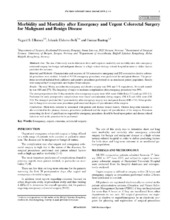| dc.contributor.author | Ellensen, Vegard Skalstad | en_US |
| dc.contributor.author | Elshove-Bolk, Jolande | en_US |
| dc.contributor.author | Baatrup, Gunnar | en_US |
| dc.date.accessioned | 2011-02-10T12:02:59Z | |
| dc.date.available | 2011-02-10T12:02:59Z | |
| dc.date.issued | 2009 | eng |
| dc.Published | The Open Colorectal Cancer Journal: 2:1-6 | en_US |
| dc.identifier.issn | 1876-8202 | |
| dc.identifier.uri | https://hdl.handle.net/1956/4494 | |
| dc.description.abstract | Abstract: Aim: The aim of this study was to determine short and long-term morbidity and mortality rates after emergency colorectal surgery for benign and malignant disease in a high volume tertiary referral hospital in order to define factors predictive for outcome. Material and Methods: Characteristics and outcome of 196 consecutive emergency and 292 consecutive elective colorectal procedures were studied. A total of 91/196 emergency procedures were performed for malignant disease. The procedures reviewed included both palliative and curative procedures performed on an unselected patient population. Results were analysed by Cox regression and Kaplan-Meier analysis. Results: The total 30-day mortality for emergency and elective surgery was 20% and 3 % respectively, 36-month mortality was 48% and 27%. The frequency of major or moderate complications after emergency procedures was 39%. The strongest predictors for 30 day mortality after emergency surgery were ASA score (Odds Ratio 2.5) and age (OR 1.5). Predictors for early postoperative complications were faecal contamination during surgery (OR 4.2) and ASA score (OR 2.0). The strongest predictor for 3 year mortality after emergency surgery was malignant disease (OR = 5.0). Other predictors for long-term outcome were procedures performed and degree of specialization of the surgeon. Conclusions: Short-term outcome is associated with patient and disease related factors, whereas long-term outcome is also correlated to the primary diseases, procedures performed and the degree of specialization of the surgeon. Decisions concerning the level of qualifications required for emergency procedures should be based upon patient and disease related factors as well as the procedure to be performed. | en_US |
| dc.language.iso | eng | eng |
| dc.publisher | Bentham Open | eng |
| dc.rights | Attribution-NonCommercial CC BY-NC | eng |
| dc.rights.uri | http://creativecommons.org/licenses/by-nc/3.0/ | eng |
| dc.title | Morbidity and Mortality after Emergency and Urgent Colorectal Surgery for Malignant and Benign Disease | en_US |
| dc.type | Peer reviewed | |
| dc.type | Journal article | |
| dc.description.version | publishedVersion | en_US |
| dc.rights.holder | Ellensen et al. | |
| dc.rights.holder | Copyright Ellensen et al.; Licensee Bentham Open. | |
| dc.identifier.doi | https://doi.org/10.2174/1876820200902010001 | |
| dc.identifier.cristin | 343500 | |
| dc.subject.nsi | VDP::Medical disciplines: 700 | eng |

